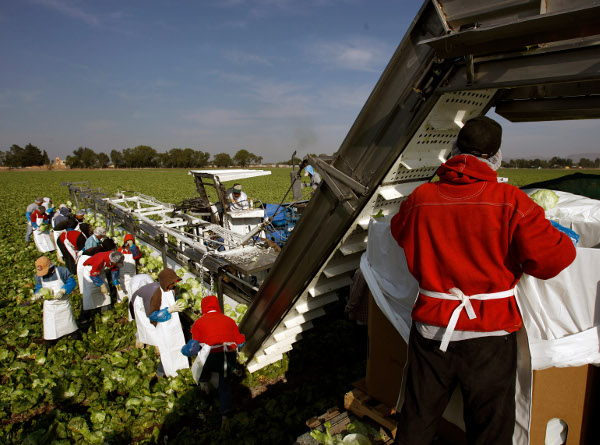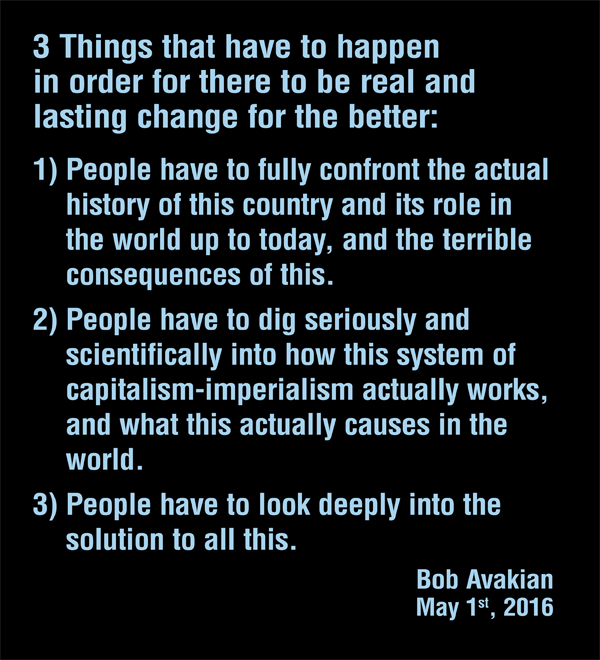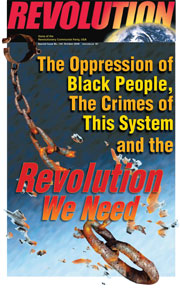Imperialism’s Mexican Miracle of Transubstantiation: How the Bones of Mexican Peasants Become Broccoli on the Tables in the U.S.
June 6, 2016 | Revolution Newspaper | revcom.us

In the feverish drive to meet the demands of the U.S. market, the water table in the region of Guanajuato has been depleted and wells in the area have dried up. Farmers are pumping deeper and deeper into the ground to water these crops and dredging up water that’s 10,000 to 35,000 years old—and tainted with arsenic and fluoride in quantities that are poisonous to humans. Above, farm workers at a U.S.-owned lettuce plantation, Guanajuato, Mexico, March 2008. (AP photo)
Question: What’s the connection between the fresh broccoli on the dinner plates of most American households and the aching bones and blackened teeth of villagers in Mexico?
The answer begins in the state of Guanajuato, a dry region in central Mexico. Yet this dry region grows 70,000 tons of broccoli per year, almost entirely to export out of the country. And broccoli needs water to grow. In the feverish drive to water these crops and meet the demands of the U.S. market, the water table in the region has been depleted and wells in the area have dried up. Farmers are pumping deeper and deeper into the ground to water these crops and dredging up water that’s 10,000 to 35,000 years old—and tainted with arsenic and fluoride in quantities that are poisonous to humans.
A recent New York Times article described the small village of San Antonio de Lourdes, not thirty minutes away from these lush fields (“Prosperous Mexican Farms Suck Up Water, Leaving Villages High and Dry,” Elisabeth Malkin, May 19). There the villagers huddle around a new water tank praying desperately for rain to fill it. With their well dried up, it’s the only source of water for the meager crops of corn and beans that are their main source of food. Many of the residents have blackened teeth and suffer severe pain in their joints, one 39-year-old man virtually crippled from the pain in his feet. Numerous people in the village are suffering from kidney disease, one young woman only 16 years old. A 51-year-old woman whose kidneys failed a year ago spoke of her six sons who have left for the U.S. to find work and send back money for her dialysis treatments: “They are working to cure me,” she said. But three other people from the village suffering from kidney disease have recently died.
Bob Avakian, "Why do people come here from all over the world?"
This leads to another question: How did it come to be this way? On one level, to really understand what’s causing this poisoning of the people, we have to go back almost 170 years, to the U.S. war against Mexico. The U.S. invaded the country, stole one-third of its territory, and put the part that it did not steal under its thumb.
But even with that, throughout much of the 20th century, Mexico had an agriculture-based economy and was able to feed itself with small-scale farming. But increasingly U.S. capital began encroaching on Mexican agriculture, establishing large commercial farms for export, particularly in the north.
In 1992 this process went into overdrive when Mexico amended the clause in its Constitution that had declared all land, water, and mineral rights to be the property of the Mexican people. This new amendment opened up small rural landholdings for purchase by foreign investors. Huge conglomerates in the U.S. bought up land throughout the country and set up farms for export agriculture. The government agency (Conasupo), which had previously bought agricultural products from the peasants, was abolished and credit to small farmers was cut off.
Then, with the implementation in 1994 of the North American Free Trade Agreement (NAFTA), this intensified. Under the terms of the agreement, the Mexican government was forced to cut agricultural subsidies on corn, beans, sugar, and milk that had protected local farmers. This opened up the market for U.S.-grown corn and other agricultural products, which are heavily subsidized by the U.S. government and therefore much cheaper than what local farmers in Mexico can grow.

With huge quantities of corn and beans from the U.S. flooding the market in Mexico, there is no way for small-scale farmers to compete. Profits pour into the U.S. agro-industry, while peasants like those living in San Antonio de Lourdes are driven off the land in search of another way to survive. As the NAFTA treaty was being negotiated, a high official of Mexico’s Department of Agriculture said: “The possibility of expelling 15 million Mexicans from their lands was considered acceptable, an undesirable but necessary effect of the modernization of the rural productive apparatus.”
Clearly, “free trade” under imperialism means free exploitation of the people and resources and the molding of the economy of a country like Mexico to meet the needs of big financial interests in the United States, opening it up for further penetration and control by the U.S.
So the people uprooted from the countryside are forced into massive shantytowns ringing Mexico City, or else make the perilous and often horrific attempt to cross the border to the U.S. Others are bitterly exploited by the huge factory farms producing food for the U.S. market. They live in rat infested camps encircled with barbed wire fences and are forced into debt at the company stores just to purchase the bare necessities for survival on the meager wages they receive. (See “Product of Mexico,” Los Angeles Times, December 7, 2014) Those left behind in the villages have seen their communities depleted and poisoned as the productive capacity of the country is put to the service of the U.S. market and huge profits are reaped by agricultural conglomerates in the U.S.
Mexico has gone from being a food self-sufficient country to a state of food dependency. Now to feed itself Mexico must import $10.1 billion of corn, wheat, and other products while its entire agricultural base has been reconfigured to feed people in the U.S. and put fresh vegetables and fruits on their tables—$12.7 billion in tomatoes, melons, lettuce, broccoli, and other fresh and frozen vegetables and fruits. That is the price of fresh vegetables under imperialism.
A price that cannot be tolerated... and a world that must be radically transformed.
Volunteers Needed... for revcom.us and Revolution
If you like this article, subscribe, donate to and sustain Revolution newspaper.








